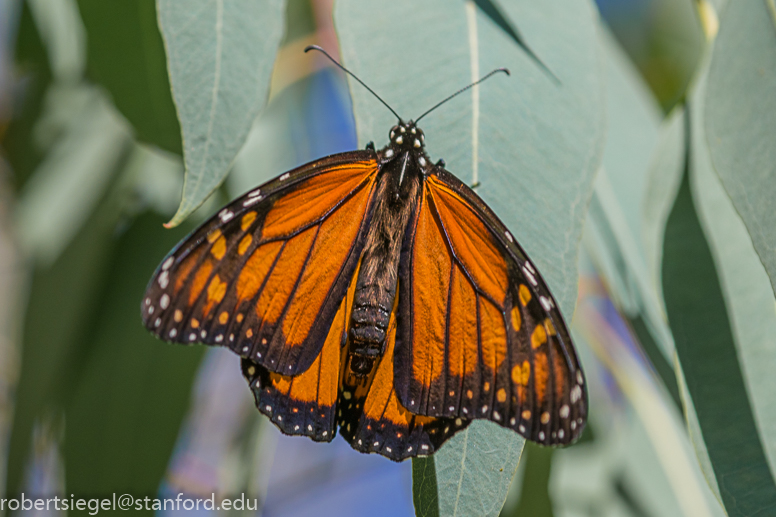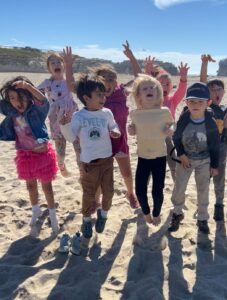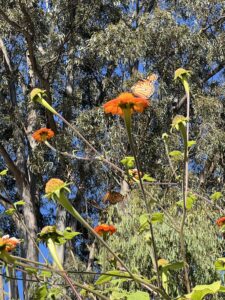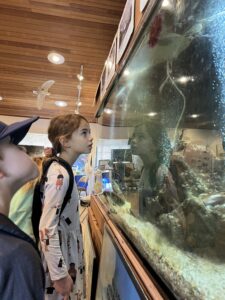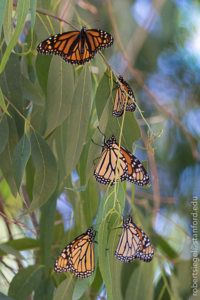 On a recent day, curious Mount Madonna School (MMS) first grade students followed the “Monarch Trail,” an elevated, wooden path at Natural Bridges State Beach in Santa Cruz that leads to a small viewing deck. There, surrounded by a grove of towering Eucalyptus trees, the students’ faces turned upward in awe, seemingly mesmerized by the abundant clusters of Monarch butterflies holding fast to tree branches and flying all around them. The students’ visit was part of their school life sciences curriculum and helped to bring the classroom lessons alive.
On a recent day, curious Mount Madonna School (MMS) first grade students followed the “Monarch Trail,” an elevated, wooden path at Natural Bridges State Beach in Santa Cruz that leads to a small viewing deck. There, surrounded by a grove of towering Eucalyptus trees, the students’ faces turned upward in awe, seemingly mesmerized by the abundant clusters of Monarch butterflies holding fast to tree branches and flying all around them. The students’ visit was part of their school life sciences curriculum and helped to bring the classroom lessons alive.
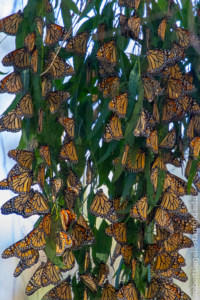 “Mount Madonna first graders are studying native California endangered animals and what we can do to protect them,” said teacher Rochelle Saxton. “There are a couple of butterfly species native to California and categorized as endangered. Some of these are endangered because of habitat destruction and humans consuming more than what they need. As a class, we have been talking about things we can do to help butterflies to thrive.”
“Mount Madonna first graders are studying native California endangered animals and what we can do to protect them,” said teacher Rochelle Saxton. “There are a couple of butterfly species native to California and categorized as endangered. Some of these are endangered because of habitat destruction and humans consuming more than what they need. As a class, we have been talking about things we can do to help butterflies to thrive.”
The students’ learning journey included time at the nearby beach for lunch and sand play, a docent-led Monarch’s presentation and the much-anticipated tour of the grove.
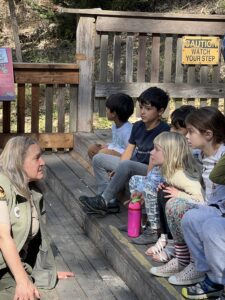 “It was a really wonderful day,” said Saxton. “During the tour students learned about the Monarchs’ dwindling population, how they migrate to escape the winter cold in Santa Cruz’s milder climate and what people can do to support conservation efforts.”
“It was a really wonderful day,” said Saxton. “During the tour students learned about the Monarchs’ dwindling population, how they migrate to escape the winter cold in Santa Cruz’s milder climate and what people can do to support conservation efforts.”
Saxon said the Natural Bridges docent was so pleased with the first graders’ enthusiasm and thirst for knowledge, that she ventured outside of the basic life cycle talk and began discussing the important role butterflies play in gardens, the pollination process and why it is important for humans.
“This was really great because we are talking about how our interactions lead to consequences in our environment,” said Saxton. “It really helped students understand the impact their choices have on not only butterflies, but us too!”
The Mount Madonna School program allows for an abundance of off-campus learning journeys each year for all grade levels, preschool through high school, to support and enhance the classroom curriculum.
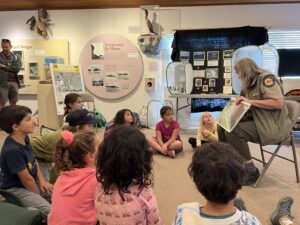 “Visiting the Monarchs provided students with a context for this area of study and made it meaningful,” said Saxton. “It brought the abstract concept and big idea of life cycles to life. Students were able to see, observe and hear about butterflies’ various life cycle stages. Through this hands-on experience, students were more emotionally and intellectually engaged, making the experience more memorable and stimulating than the learning that happens solely in a classroom.
“Visiting the Monarchs provided students with a context for this area of study and made it meaningful,” said Saxton. “It brought the abstract concept and big idea of life cycles to life. Students were able to see, observe and hear about butterflies’ various life cycle stages. Through this hands-on experience, students were more emotionally and intellectually engaged, making the experience more memorable and stimulating than the learning that happens solely in a classroom.
“There is nothing like walking through a Monarch grove and marveling at the colorful and fragile beauty,” she continued. Seeing their vibrant colors up close and watching how the light touched their wings – it was magical from the students’ perspective. Being in nature and seeing butterflies up close and in-person, helps foster students’ curiosity and wonder about the natural world. I’m hoping It will inspire and motive these children to become environmental stewards of the future.”
###
Monarch butterfly photos by Robert Siegel, MD, Ph.D., Stanford University; used with permission.

